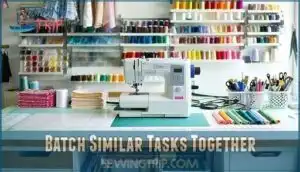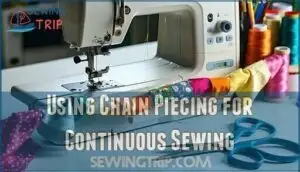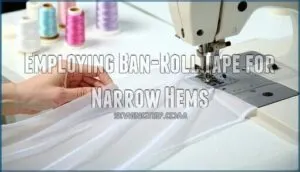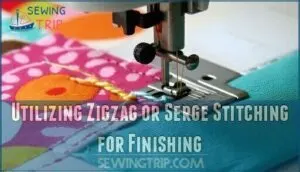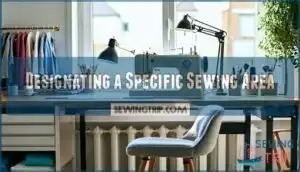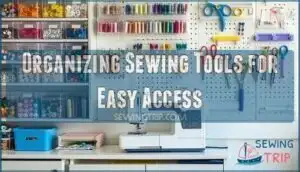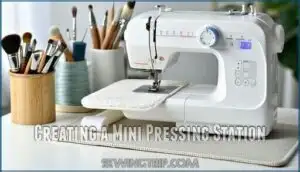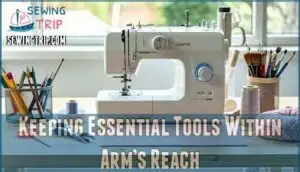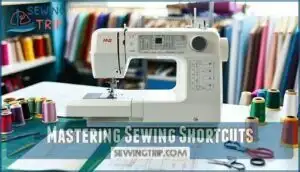This site is supported by our readers. We may earn a commission, at no cost to you, if you purchase through links.
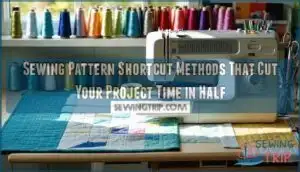
Start by batching similar tasks—cut all pieces first, then sew all seams together using chain piecing. Set up your workspace efficiently with tools within arm’s reach and create a mini pressing station nearby.
Choose the right needle for your fabric from the start, and use zigzag stitching for quick edge finishing instead of traditional methods. Trace patterns with two pencils for instant seam allowances, and employ bias tape for speedy edge binding.
These time-tested techniques transform lengthy projects into manageable sessions. Master sewers know these insider tricks make the difference between weekend warriors and efficient creators, using methods that are truly time-tested.
Table Of Contents
- Key Takeaways
- Sewing Pattern Basics
- Top 10 Sewing Essentials
- 1. Butterick Womens Knit Shirt Sewing Pattern
- 2. Simthread Assorted Prewound Bobbins Sewing Thread
- 3. McKesson Medical Exam Table Paper Rolls
- 4. Clover Nancy Zieman Stick N Stitch
- 5. Quilting Rulers Sewing Acrylic Cutting Set
- 6. Sewing Rulers Set French Curve
- 7. Taylor Seville Extra Fine Silk Pins
- 8. Sewing Clips Quilting Crafting Assorted Colors
- 9. Staple Ban-Rol Waistband Interfacing 1 inch
- 10. White Cotton Buckram Fabric Yard
- Efficient Sewing Techniques
- Optimizing Sewing Workspace
- Mastering Sewing Shortcuts
- Frequently Asked Questions (FAQs)
- Conclusion
Key Takeaways
- Batch similar tasks together – You’ll slash project time by cutting all pieces first, then sewing all seams using chain piecing instead of jumping between different activities randomly.
- Organize your workspace strategically – You’ll work faster when you keep essential tools within arm’s reach and create a mini pressing station beside your sewing machine.
- Choose the right tools from the start – You’ll prevent costly mistakes and save time by selecting the proper needles for your fabric and using zigzag stitching for quick edge finishing.
- Master efficient techniques like bias tape application – You’ll achieve professional results quickly by using continuous bias strips for edge finishing and tracing patterns with two pencils for instant seam allowances.
Sewing Pattern Basics
You’ll save hours on every project when you master these essential pattern basics that turn complex sewing into simple, manageable steps.
These foundational skills help you work smarter, not harder, by streamlining fabric selection, machine setup, and task organization from the very start, which are complete concepts that improve your overall sewing experience.
Understanding Fabric Selection
Understanding fabric selection is your foundation for successful sewing projects.
The right fabric choice determines how your finished garment will look, feel, and perform.
Here’s your fabric selection roadmap:
- Check fiber content – Cotton breathes well, polyester resists wrinkles, and blends offer benefits of both materials for versatile wear.
- Examine weave structures – Tight weaves work best for structured garments, while loose weaves create flowing, draped silhouettes.
- Test drape analysis – Hold fabric up to see how it falls naturally, ensuring it matches your pattern’s intended style.
- Consider print direction – Directional prints need extra yardage and careful pattern placement to avoid upside-down motifs on your finished piece.
To guarantee longevity, consider fabric properties and care instructions.
Mastering Machine Setup and Threading
Proper sewing machine setup prevents frustration and saves hours on every project.
Start with machine maintenance by cleaning lint from the bobbin case and oiling moving parts. Check thread tension settings – they should create balanced stitches without puckering.
Master bobbin winding techniques for smooth thread flow. Match needle types to your fabric weight and fiber content.
Select appropriate stitch settings for your project requirements. Regular care guarantees optimal sewing performance for optimal results, ensuring a successful sewing experience with proper maintenance.
Breaking Tasks Into Small Steps for Efficiency
Once you’ve threaded your machine properly, break each sewing project into smaller, manageable chunks.
Simplified Sewing becomes reality when you master Task Segmentation. Instead of tackling an entire garment at once, focus on one component at a time.
Cut all pieces first, then move to marking, followed by stitching seams. This Step Clarity approach transforms overwhelming projects into Focused Sewing sessions, making sewing shortcuts feel natural while boosting your confidence through timesaving techniques.
Top 10 Sewing Essentials
Having the right tools makes all the difference when you’re working with sewing patterns and want to speed up your projects.
These ten essential items will help you cut fabric more accurately, mark patterns precisely, and finish seams professionally without wasting time on multiple trips to your sewing box.
1. Butterick Womens Knit Shirt Sewing Pattern
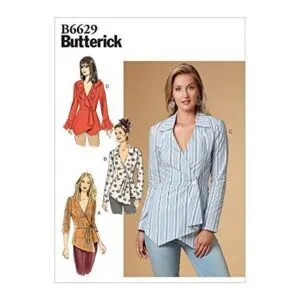
Your trusty Butterick women’s knit shirt pattern becomes your secret weapon for lightning-fast garment construction.
You’ll love how these patterns typically include just three to five pattern pieces, dramatically reducing your cutting and prep time. The "Easy" rating means you won’t get bogged down with complicated instructions.
Choose patterns covering sizes 4-26 for inclusive fitting options. With clear guidelines for stretch fabrics like jersey and cotton blends, you’ll achieve professional results quickly.
The multi-view options give you several shirt variations in one envelope, maximizing your investment while minimizing project complexity.
Best For: Beginner to intermediate sewists who want quick, professional-looking handmade tops with minimal complexity and maximum wardrobe impact.
- Limited to knit fabrics only, which may restrict fabric choices and require specific sewing techniques like serging or zigzag stitches
- Collar and yoke construction can be challenging for true beginners, potentially requiring additional tutorials or intermediate skills
- Physical pattern format lacks the convenience of instant PDF downloads for immediate project starts
- Simple construction with only 3-5 pattern pieces reduces cutting time and complexity while still delivering professional results
- Multi-view options provide several shirt variations in one pattern envelope, offering excellent value and versatility for different occasions
- Clear stretch fabric guidelines and inclusive sizing (4-26) ensure proper fit and comfort across various body types
2. Simthread Assorted Prewound Bobbins Sewing Thread
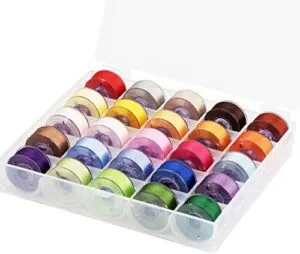
When you’re racing against deadlines, prewound bobbins become your secret weapon for slashing setup time.
Simthread’s 25-piece assorted bobbin set delivers 140 yards per bobbin with 60WT polyester thread that won’t snap mid-stitch.
These factory-wound bobbins hold 30-50% more thread than hand-wound versions, meaning fewer interruptions during complex projects.
Compatible with Brother, Singer, and Janome machines, they eliminate the tedious winding process entirely.
You’ll spend more time creating and less time preparing, transforming your workflow efficiency with these bobbins, making them a valuable asset for complex projects.
Best For: Sewers and embroiderers who need efficient, time-saving thread solutions for high-volume projects or commercial work.
- Factory-wound precision holds 30-50% more thread than hand-wound bobbins, reducing project interruptions
- Compatible with major machine brands including Brother, Singer, and Janome for versatile use
- 60WT polyester thread provides strong tensile strength with minimal breakage during complex stitching
- Random color assortment may not meet specific project color requirements
- Thread strength suitable for decorative work but may not match premium thread quality
- Some bobbins may arrive unwound, requiring rewinding before use
3. McKesson Medical Exam Table Paper Rolls
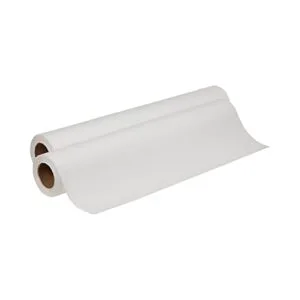
Drafting sewing patterns becomes effortless when you discover this unexpected ally from the medical world. McKesson medical exam table paper rolls offer sewers a smooth, tear-resistant surface perfect for pattern tracing and drafting.
The 21-inch width provides ample space for most garment pieces, while the 225-foot length means you’ll have plenty for multiple projects. You’ll love how easily pencil lines glide across the surface, creating clean, precise markings.
Unlike flimsy tissue paper, this durable material won’t rip during adjustments, saving you time and frustration while creating professional-quality patterns. For intricate designs, sewers can also use freezer paper templates to achieve accuracy, making it an ideal tool for those seeking accuracy and precision in their work.
Best For: Sewers and crafters who need affordable, large-format paper for pattern drafting and workspace protection.
- Smooth, tear-resistant surface ideal for precise pattern tracing and markings
- 21-inch width and 225-foot length provides ample material for multiple sewing projects
- Cost-effective alternative to specialty pattern papers with excellent value for bulk quantities
- Matte texture may not suit those preferring smoother surfaces for certain applications
- Can tear with jagged edges despite being stronger than tissue paper
- May require pattern redrawing due to paper’s inherent flimsiness compared to premium options
4. Clover Nancy Zieman Stick N Stitch
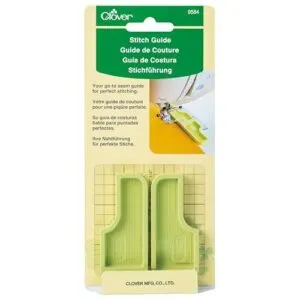
Perfect seam guides make all the difference when you’re chasing precision. The Clover Nancy Zieman Stick N Stitch features a 2-piece interlocking design with repositionable adhesive that won’t leave residue on your machine.
You’ll get six functions in one tool: straight stitching, quilting strips, and curves. The tacky underside repositions hundreds of times and washes clean with soap.
This versatile guide works on both sewing machines and sergers, helping you maintain consistent seam allowances from 1/4" to 1". It’s especially valuable for quilters needing accurate piecing and beginners wanting straight stitches.
Best For: Quilters and garment sewers who need consistent seam allowances and want a versatile, repositionable guide that works on multiple machine types without leaving residue.
- Overpriced considering the simple construction and production costs
- Can shift slightly under pressure during sewing, requiring occasional repositioning
- Must be removed when changing top-loading bobbins, interrupting workflow
- Six-in-one functionality handles straight stitching, curves, and topstitching with precise seam allowances from 1/4" to 1"
- Repositionable adhesive stays tacky through hundreds of uses and washes clean with soap and water
- Works on both sewing machines and sergers without magnetic interference, perfect for computerized machines
5. Quilting Rulers Sewing Acrylic Cutting Set
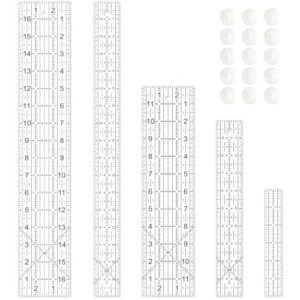
Beyond measuring twice and cutting once, acrylic quilting rulers revolutionize your fabric cutting workflow.
This five-piece set includes rulers ranging from 6 to 17 inches, each featuring clear black markings on white backgrounds for easy reading.
The non-slip grip rings prevent movement during cutting, reducing errors that waste precious fabric, and you’ll cut material loss by up to 20% compared to freehand methods while achieving precise 1/8-inch increments.
The transparent acrylic lets you align patterns perfectly, and the durable construction withstands years of rotary cutter use without compromising accuracy, making it a valuable tool for precise fabric cutting with clear black markings and a non-slip grip.
Best For: Quilters and sewers of all skill levels who need precise fabric cutting with multiple ruler sizes for various projects.
- Not super accurate for precision measuring applications beyond quilting and crafting
- 3mm thickness may be too thin for some heavy-duty cutting tasks
- Acrylic material can show scratches over time with heavy rotary cutter use
- Complete 5-piece set with sizes from 6 to 17 inches covers most quilting and sewing tasks
- Non-slip grip rings prevent movement during cutting, reducing fabric waste by up to 20%
- Clear black markings on white background with 1/8-inch increments ensure easy reading and precise measurements
6. Sewing Rulers Set French Curve
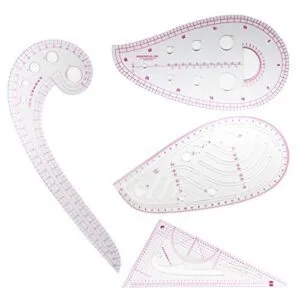
Precision becomes your closest ally when drafting professional patterns.
French curve rulers eliminate guesswork by creating smooth, accurate curves for armholes, necklines, and waistlines. You’ll trace consistent shapes without jagged edges that plague freehand drawing.
These transparent plastic tools let you see pattern markings underneath while drawing perfect curves. Choose sets with multiple shapes—classic French curves for general use and hip curves for lower garment areas.
They’re essential for pattern adjustments and grading between sizes, ensuring your garments fit properly every time.
Best For: Seamstresses, fashion design students, and pattern makers who need precise curve drafting for professional-quality garments with accurate armholes, necklines, and waistlines.
- Thin, flexible material may require careful handling and solid work surfaces for maximum accuracy
- Print markings can be difficult to see for some users, potentially affecting precision
- May need larger sizes for specific projects like full skirts or trousers beyond the included dimensions
- Creates smooth, professional curves that eliminate jagged edges and guesswork in pattern making
- Transparent design allows you to see underlying pattern markings while tracing curves accurately
- Multiple shapes included (French curve, hip curve, triangular, multi-function) handle diverse sewing projects from armholes to waistlines
7. Taylor Seville Extra Fine Silk Pins
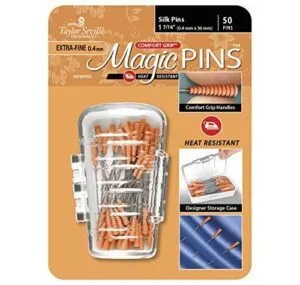
Your secret weapon for delicate fabrics lies in these ultra-fine pins.
Your most delicate fabrics deserve pins that won’t leave a trace.
Taylor Seville’s Extra Fine Silk Pins measure just 0.4mm thick and 1-7/16 inches long, gliding through silk, satin, and lightweight cotton without leaving visible holes.
The heat-resistant comfort grip handles let you iron right over them, eliminating time-consuming pin removal.
Their razor-sharp points penetrate tightly woven fabrics effortlessly, while the bright blue heads stay visible on your work surface.
These pins heal fabric quickly after removal, making them perfect for professional-quality results on your most precious materials, with visible holes being a thing of the past.
Best For: Seamstresses, quilters, and fashion designers working with delicate fabrics like silk, satin, and lightweight cotton who need precision without fabric damage.
- Higher price point compared to standard pins may not fit all budgets
- Short 1-7/16 inch length may be limiting for thicker fabric layers or certain applications
- Extra fine construction makes them more delicate and potentially easier to bend or lose
- Ultra-fine 0.4mm diameter prevents visible holes and fabric distortion on delicate materials
- Heat-resistant handles allow ironing directly over pins, eliminating workflow interruptions
- Comfort grip design reduces hand fatigue during extended use and provides secure handling
8. Sewing Clips Quilting Crafting Assorted Colors
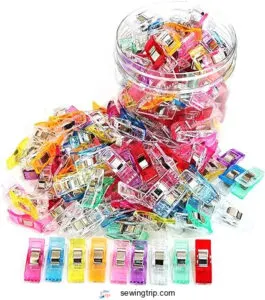
Sewing clips revolutionize your workflow by replacing pins entirely, these colorful plastic grips hold multiple fabric layers without piercing, preventing damage to delicate materials like vinyl or silk.
You’ll save precious minutes since clips attach and remove faster than pins, their flat backs glide smoothly under your presser foot, eliminating the risk of broken needles.
The transparent design lets you see exactly where you’re clipping, while measurement markings guarantee consistent seam allowances every time, and clips are particularly useful for working with delicate materials like silk, and they offer a way to work efficiently with multiple fabric layers.
Best For: Quilters, sewists, and crafters who work with delicate fabrics, multiple layers, or want a safer, faster alternative to traditional pins.
- Small 0.9cm opening limits use with very thick fabrics or bulky layers, making them unsuitable for heavy upholstery projects
- Plastic construction can break under excessive pressure, with some users reporting durability issues
- Limited to lighter-weight applications compared to heavy-duty pins for industrial or thick material work
- Faster workflow with quick attachment and removal, plus flat backs that glide smoothly under presser feet without breaking needles
- Protects delicate materials like vinyl, silk, and leather by holding fabric without piercing or creating permanent holes
- Transparent design with measurement markings allows precise placement and consistent seam allowances
9. Staple Ban-Rol Waistband Interfacing 1 inch
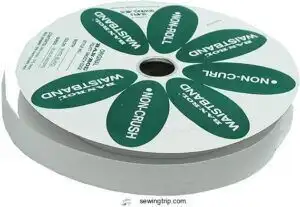
Waistband woes vanish when you discover Ban-Rol interfacing’s game-changing properties.
This crush-proof marvel won’t curl or roll like traditional options, maintaining that crisp, professional finish you’re after.
Its velvet-smooth edge glides effortlessly during construction, while the synthetic blend provides lasting support through countless wears and washes.
You’ll love how it streamlines waistband creation and doubles as a hemming aid for delicate fabrics.
Best For: Professional seamstresses, home tailors, and intermediate sewists who need reliable waistband interfacing that maintains structure and creates crisp finishes in garments.
- Large 50-yard quantity may be excessive for small projects or occasional sewers, leading to waste
- Packaging issues including flimsy cardboard and plastic spool hubs that may fall off during shipping
- Only available in white color, which may not suit all fabric choices or design preferences
- Won’t curl, roll, or collapse like traditional interfacing, ensuring professional-looking waistbands that maintain their shape through wear and washing
- Versatile beyond waistbands – works excellently for creating smooth rolled hems on delicate fabrics like chiffon and jersey
- Crush-proof synthetic blend construction provides lasting support and durability while remaining easy to sew through
10. White Cotton Buckram Fabric Yard
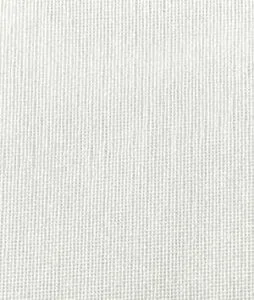
Cotton buckram’s stiff structure revolutionizes your sewing projects by eliminating multiple steps.
Stiff cotton buckram transforms sewing by replacing multiple interfacing steps with one revolutionary material.
This 100% cotton mesh fabric provides instant reinforcement for collars, cuffs, and waistbands without adding bulk.
You’ll save hours by skipping additional interfacing layers since buckram delivers both support and breathability in one material.
Its moldable properties when damp let you shape elements perfectly, then lock them in place as it dries.
Perfect for costumes, millinery, and structured garments that demand professional results fast.
Best For: Sewers and crafters who need structured support in their projects without the bulk of multiple interfacing layers, especially those working on costumes, hats, and formal garments.
- Eliminates need for additional interfacing layers, saving time and reducing bulk in structured garments
- Moldable when damp allows for precise shaping that locks in place when dry, perfect for millinery and costume work
- Combines breathability with stiffness, providing comfort in wearable items while maintaining professional structure
- Some users find it not stiff enough for certain applications, potentially requiring additional reinforcement
- Higher price point compared to basic interfacing options may not suit budget-conscious projects
- Visibility issues when used for specialty applications like fursuits, often requiring modifications or alternatives
Efficient Sewing Techniques
You’ll save hours on your sewing projects when you master these time-tested shortcut techniques.
These methods help you work smarter, not harder, by streamlining repetitive tasks and reducing the need to constantly stop and start your machine, which ultimately helps you work smarter.
Batch Similar Tasks Together
Most sewers jump between different tasks randomly, but smart project grouping transforms your workflow optimization.
Batch similar activities like cutting all pieces first, then stitching all seams together.
This focused sewing approach eliminates constant machine adjustments and maintains your rhythm.
Task prioritization through batching reduces setup time by 50%.
These timesaving techniques keep you in the zone longer, making efficient sewing feel effortless and boosting your time management skills substantially.
Using Chain Piecing for Continuous Sewing
Chain piecing transforms your sewing workflow into a streamlined assembly line.
You’ll feed fabric pieces through your machine without lifting the presser foot or cutting threads between pieces.
This continuous sewing technique creates a chain of connected pieces that dramatically reduces thread waste and setup time.
Simply sew one seam, then immediately guide the next piece under the needle.
You’ll cut apart your chain when finished, saving precious minutes on every project while maintaining professional results.
To avoid issues, remember to check sewing machine tension for consistent stitches, ensuring a smooth sewing workflow.
Employing Ban-Roll Tape for Narrow Hems
When you’re tackling delicate fabrics like silk or chiffon, Ban-Roll tape transforms frustrating hemming into a streamlined process.
This reusable interfacing creates consistently narrow hems without the bulk or waviness that plagues traditional hemming techniques on lightweight materials. The technique is especially useful for achieving finer finishes on curved seams.
Here’s your step-by-step approach:
- Prepare the tape – Cut Ban-Roll slightly longer than your hem, then remove 3-5 threads to create a flexible "comb" edge
- Secure and stitch – Align the frayed edge with your fabric’s raw edge, stitch through the comb only, then wrap and edge-stitch
- Remove cleanly – Gently slide out the tape after hemming for professional results every time
Utilizing Zigzag or Serge Stitching for Finishing
Why waste time with multiple finishing passes when you can tackle both sewing and edge finishing in one go?
Zigzag or serge stitching lets you sew seams while preventing fraying simultaneously. This sewing shortcut saves precious minutes on every project by combining two steps into one efficient motion.
| Serger vs Zigzag | Best Applications |
|---|---|
| Serger creates professional overlock edges | Knits, activewear, lingerie |
| Zigzag offers adjustable stitch width settings | Wovens, home décor, quilting |
| Serger cuts and finishes in one pass | High-volume production work |
| Zigzag allows precise fabric edge control | Delicate fabrics, curved seams |
| Both maintain thread tension balance | Any project needing durability |
Optimizing Sewing Workspace
Your workspace setup directly impacts how quickly you’ll complete sewing projects. A well-organized area with tools within reach eliminates time-wasting searches and keeps your creative flow uninterrupted.
Designating a Specific Sewing Area
Your dedicated space becomes your creative command center.
Choose a corner, room, or table where you’ll consistently work on sewing projects.
Proper lighting importance can’t be overstated—bright light prevents eye strain and improves accuracy.
Set up an ergonomic setup with your chair at the right height.
Smart storage solutions keep everything within reach while minimizing distractions from household chaos.
Organizing Sewing Tools for Easy Access
Beyond scattered scissors and tangled threads, smart sewing organization transforms your creative space.
Store toolbox essentials in clear containers where you can see everything at a glance. Rolling carts keep frequently used items mobile, while pegboard organization maximizes wall space for tools and accessories.
- Magnetic strips hold pins, needles, and small metal tools within easy reach
- Clear containers sort buttons, zippers, and notions by type or project
- Rolling carts provide mobile storage that moves between cutting table and machine
A tidy workspace might include a magnetic pin solution.
Creating a Mini Pressing Station
Set up your pressing station beside your sewing machine for instant seam pressing.
Position the ironing board height level with your workspace to eliminate awkward reaching.
Use heat resistant surfaces and portable station benefits like wool mats for quick pressing.
Consider a mini ironing board for small spaces.
Smart space saving ideas include foldable boards and pressing tool storage within arm’s reach for maximum sewing efficiency.
Keeping Essential Tools Within Arm’s Reach
Why struggle with constant trips to your supply box when smart workspace layout puts everything at your fingertips? Efficient workflow demands organized sewing with essential sewing tools positioned strategically.
This ergonomic sewing approach transforms your productivity through tool accessibility. Keep these sewing tools and accessories within arm’s reach:
- Thread snips for quick cuts
- Seam ripper for corrections
- Measuring tape for accuracy
- Pins and clips for holding
- Marking tools for precision
This sewing project organization creates seamless sewing efficiency and powerful sewing shortcuts.
Mastering Sewing Shortcuts
When you’re ready to take your sewing skills to the next level, these time-saving shortcuts will transform how you approach every project.
You’ll discover professional techniques that experienced sewers use to work faster without sacrificing quality, and learn how to apply these methods to enhance your sewing experience with time-saving shortcuts.
Choosing The Correct Needle for Fabric
Once you’ve organized your workspace efficiently, selecting the right sewing machine needles becomes your next time-saving strategy.
Matching needle size to fabric type prevents skipped stitches, thread breaks, and fabric damage that slow your progress.
| Fabric Type | Needle Size | Needle Point |
|---|---|---|
| Lightweight cotton, silk | 70/10, 80/12 | Sharp/Universal |
| Medium weight denim, canvas | 90/14, 100/16 | Universal/Denim |
| Knits, jersey, stretch fabrics | 75/11, 90/14 | Ballpoint/Stretch |
Thread compatibility matters too—heavier fabrics need larger needle eyes for thicker threads.
Your sewing machine tips manual shows recommended needle selection for different projects, ensuring superior stitch quality every time.
Using 2 Pencils When Tracing Sewing Patterns
Tape two pencils together for perfect sewing pattern tracing that doubles your accuracy boost. This simple sewing hack creates parallel lines instantly, giving you both cutting and stitching lines in one pass.
Mechanical pencil types offer superior line clarity compared to regular pencils.
Pattern stability improves when you use pattern weights to prevent shifting. These timesaving techniques prevent smudging while maintaining consistent seam allowances for professional sewing shortcuts.
Making The Waist Bigger on Jeans With Ease
Transforming tight jeans into comfortable favorites doesn’t require professional alterations.
Simple waistband adjustment techniques can add 2-4 inches in under 15 minutes using basic tools.
Quick jean modification methods include:
- Elastic Inserts – Add 2-inch elastic at side seams for instant flexibility
- Adding Gussets – Insert triangle panels for both waist and hip expansion
- Fabric Wedges – Sew rectangular panels into waistband for seamless denim expansion
- Concealed Extensions – Use invisible techniques preserving original topstitching appearance
Applying Bias Strips for Efficient Edge Finishing
Applying bias strips continuously saves precious sewing time while creating professional-looking finishes.
You’ll cut your edge finishing work in half by preparing all strips at once and applying them without stopping between sections.
Understanding fabric grain is essential for achieving the best results with bias strips, as explained in Understanding fabric grain.
| Bias Strip Feature | Time-Saving Benefit |
|---|---|
| Continuous bias application | Eliminates frequent starts and stops |
| Pre-cut bias strip width | Consistent measurements every time |
| Curved edge finishing technique | Smooth application without puckering |
| Mitered corner bias method | Perfect corners without bulk |
| Multiple bias strip types ready | Quick selection for different projects |
The use of continuous bias application and pre-cut bias strip width ensures a time-saving process, allowing for efficient completion of sewing projects with a professional finish.
Frequently Asked Questions (FAQs)
How to make pattern cutting easier?
Sure, you’ll cry tears of joy when pattern cutting becomes this simple.
Use rotary cutters with self-healing mats—they’ll slash your cutting time in half compared to scissors and deliver precision that’ll make your inner perfectionist dance.
How to digitally organize sewing patterns?
You can scan patterns into PDFs, store them in cloud folders by project type, and use apps like Pinterest or Evernote to catalog photos with searchable tags for quick retrieval.
How to adjust pattern size between sizes?
While computer printers can shrink patterns instantly, hand-grading between sizes requires careful measuring.
Find the difference between your measurements and pattern sizes, then divide adjustments across multiple seam lines for smooth shifts that maintain the garment’s intended shape.
Whats the best way to transfer markings?
Use transfer paper, tracing wheel, or fabric markers to mark darts, notches, and placement lines. For delicate fabrics, try tailor’s tacks or basting stitches instead of permanent markers.
How do you grade seam allowances properly?
Perfectly precise pattern preparation prevents puckering.
Trim seam allowances in graduated layers – longest closest to garment, shortest nearest skin.
This creates smooth, flat curves without bulk, letting your finished pieces lay beautifully flat.
When should you make a muslin first?
Make a muslin when you’re trying a new pattern, adjusting fit, or working with expensive fabric.
It’s your safety net—test the fit, construction, and design details before cutting into your good material.
How to modify patterns for different heights?
Lengthening patterns requires adding length between bust and waist, waist and hip.
Shortening means removing length from these same areas.
You’ll measure, mark, cut, and adjust pattern pieces accordingly for proper fit.
Conclusion
Surprisingly, the same sewing pattern shortcut methods professional seamstresses use are available to you right now.
You’ve learned how batching tasks, chain piecing, and smart workspace organization can transform your sewing experience.
These time-tested techniques aren’t just theory—they’re practical solutions that reduce project completion time substantially.
Start implementing one shortcut method per project, and you’ll quickly discover which techniques work best for your sewing style and preferred fabrics.
- https://www.reddit.com/r/sewing/comments/tef3q3/most_efficient_and_accurate_way_to_work_with/
- https://camimade.com/how-to-use-a-sewing-pattern-5-basic-things-to-know-about-sewing-patterns/
- https://www.mabeyshemadeit.com/cutting-patterns-tips/
- https://www.youtube.com/watch?v=u5EuSGABogw
- https://www.positivelysplendid.com/time-saving-sewing-tricks/

